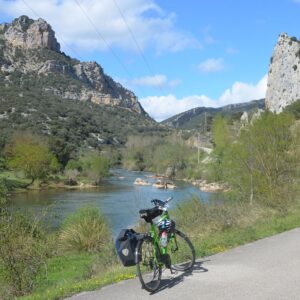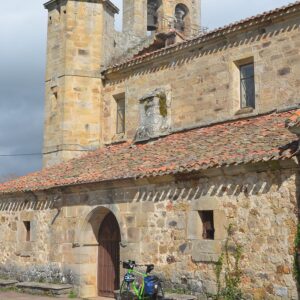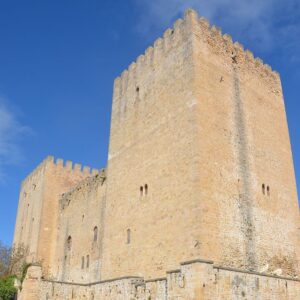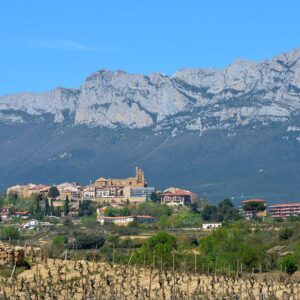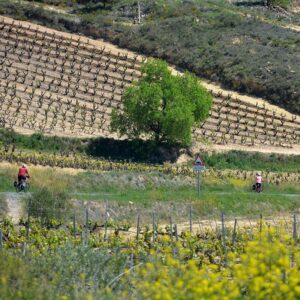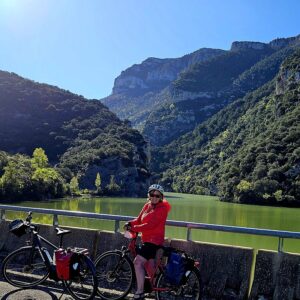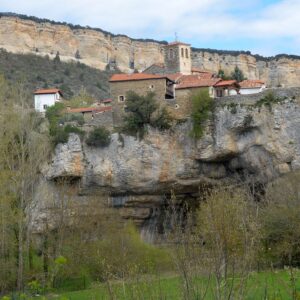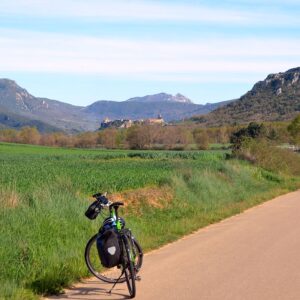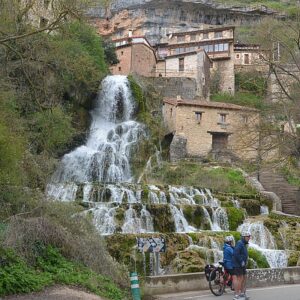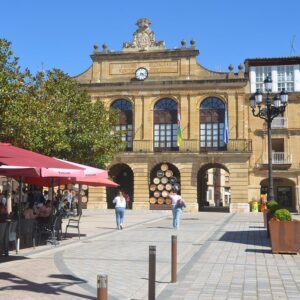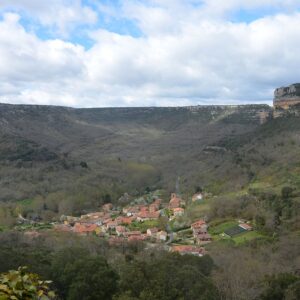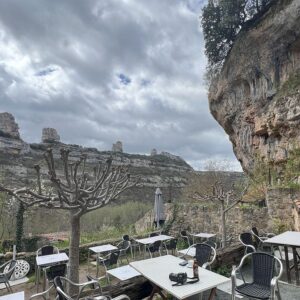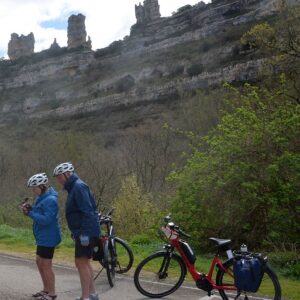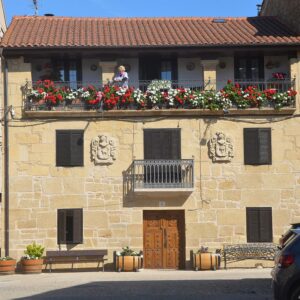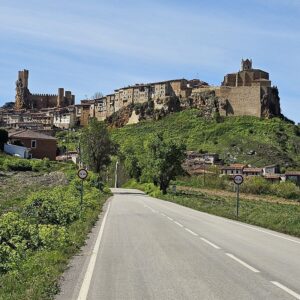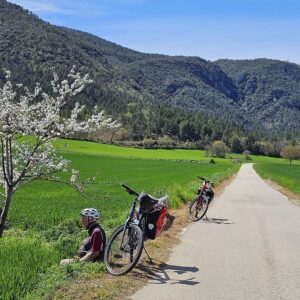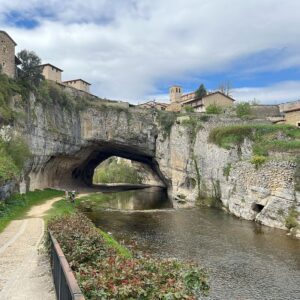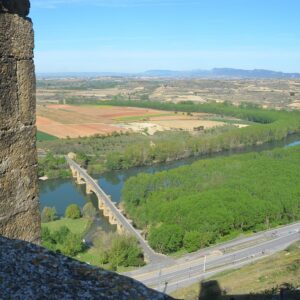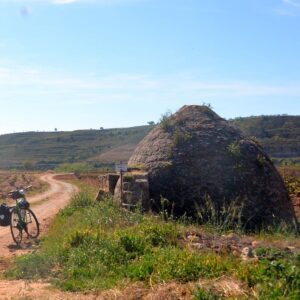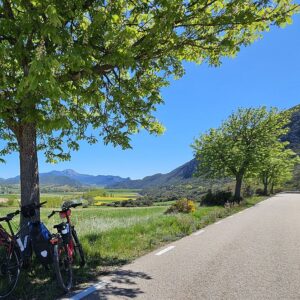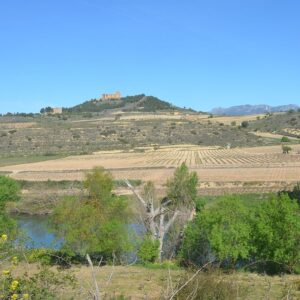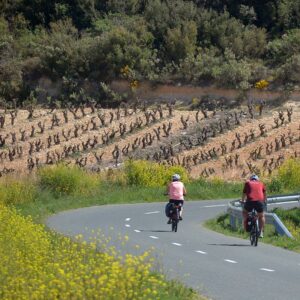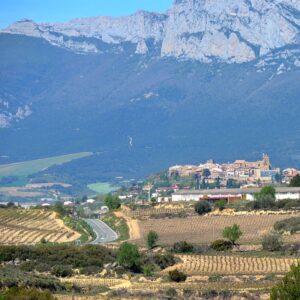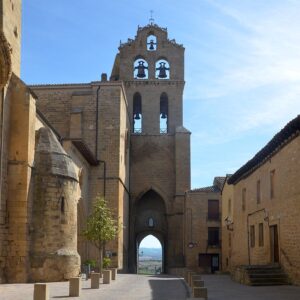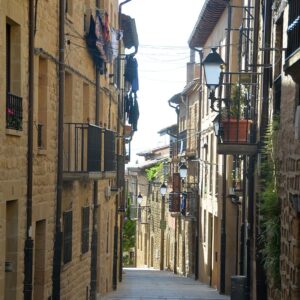River Ebro & Rioja – E-bike Adventure
Go with the River Ebro flow, cycling from its source in Green Spain’s Cantabrian mountains to the warm ochre castles, mysterious caves and endless vineyard slopes of the deliciously fruitful region of Rioja. Spin through mighty canyons where eagles hover overhead. Wonder at villages perched on rocky outcrops or cascading with waterfalls, carved into castle walls or cliffsides, lost amidst the vines or dwarfed by imposing Sierra peaks. Cantabria, Castile & Léon, Basque Country, La Rioja… on this tour, Spain’s more secret provinces line up like a row of tasting glasses, each one full to the brim with delicious discoveries, enticing you to keep dipping back in for more. Medieval monasteries, awesomely avant-garde wineries, troglodyte churches or brilliant Bogedas (wine cellars) – whatever’s up next along your rugged river valley, prestigious Spanish wine route or zig-zag path, your e-bike will help make the cycling a breeze and your secret Green Spain encounter a true breath of fresh air. Read More
Europe, Spain
Sun
Half Board (most nights)
£1,295.00
8 Days, 7 Nights
Apr - Oct
Grade 4-5 (Challenging)
Overview
An eye-opening e-bike tour through some of Green Northern Spain’s most unspoilt countryside and forgotten villages, from Cantabria’s pasture-lands to the more arid and prestigious vineyards of La Rioja.
Rich in awe-inspiring ‘Sierra’ scenery and delicious off-the-beaten-cycle-track discoveries, you’ll track down (or up!) crag-top villages like Spain’s ‘Rocamadour’ – Puentedey, explore cavern churches, canyons and more to finish up in the time-warped, walled and wine-producing village of Laguardia. With plenty of spectacular spots to sit and sip a while, this is a tour that’s sure to leave you open-mouthed and with a real taste for more.
Following mainly quiet country lanes through dramatic landscapes both along the River Ebro and into its hinterland, this cycling adventure is amongst the more challenging tours in our Spanish portfolio, but made wonderfully more accessible courtesy of our tried-and-tested fleet of electric bikes.
The tour is also available to trained cyclists wishing to use a regular bike. The tour grading (4-5 Challenging) reflects the level of difficulty if undertaken on a regular bike. If using an e-bike, we would consider that this is reduced to Grade 2-3 (Moderate).
Spain’s longest river may be 580 miles long from source to sea, but you’ll enjoy its youthful company as it carves and meanders its way from Cantabrian source, through contrasting Castile & Léon and Basque Country landscapes to La Rioja’s own rolling sea of vineyards, where you’ll wave it off on its remaining journey to the Med. When you head back to Northern Spain’s Atlantic coast, why not organise yourself some city culture and extra nights in Santander or Bilbao?
Itinerary
This bike tour is also suitable for trained cyclists who would prefer to use a hybrid bike. The allocated tour grading (4-5 Challenging) reflects the level of difficulty if undertaken on a hybrid or unassisted bike. For leisure cyclists using an e-bike, we would consider Grade 2-3 (Moderate) to be a more appropriate appraisal.
Day 1 Transfer from Santander to Cantabria’s Ebro Valley
Travel to the area and rendez-vous in Santander to get introduced to your e-bike. You can then relax on your fully organised road transfer to your ‘Pousada’ accommodation in a Southern Cantabrian rural village near Campoo (included in the tour price – journey time, one hour).
On arrival at your ‘Pousada’, there’s time to saddle up and e-cycle a while before supper – a chance to get to know your electric bike as you pedal around green mountain pastures, and take in some of the impressive ‘Alto Campoo’ backdrops.
Overnight with dinner at your accommodation: near Campoo.
Day 2 Reservoirs, rivers & rock churches
Set out for a day of unspoilt, remotely beautiful and greenest Cantabrian countryside as you cycle to discover the source of Spain’s longest river and enjoy its company to the rural town of Polientes.
With sights set on Fontibre (traditionally considered the source of the River Ebro), the ancient fortified hilltop village of Argüeso has to be a worthy mini-detour. Some fortifications here pre-date the Romans, but it’s the recently restored 13th Century Castillo de San Vincente which steals the show – truly awesome against its mountain backdrop.
On arrival in Fontibre, head for the park to spot the famous statue of Our Lady of the Pillar, standing in the river and gazing downstream… towards the Mediterranean Sea. It’s still a matter of debate, whether Spain’s main river actually rises here or near Pico de Tres Mares mountain, but the Romans confidently named the spot ‘fons iberi’ (fountain/ source of the River Ebro) and with time, the river probably lent its name to the whole Spanish (Iberian) Peninsula.
Look out for evidence of Roman occupation in the bustling old river port town of Reinosa before catching a glimpse of a much more modern-day feat of engineering – the Pantano del Ebro, Spain’s largest reservoir, opened in 1952. Constructed during the time of General Franco (1921-45), the reservoir engulfed fertile Rasa de Campoo farmland and many rural villages. Spin along to Las Rozas and the 1890 village church poking its belltower above the waters is telling reminder. A walkway makes the ‘fish cathedral’ tower accessible – a place for watery views and much reflection.
Time to cross La Robia – Western Europe’s longest narrow gauge railway line, dating from 1892 – before leaving the Ebro for monastic heights. The must-see, remote Monasterio de Montesclaros is full of history and mystery. A place of pilgrimage and practising monastery, it is home to a miraculous statue of the Virgin Mary, located in a cavern beneath the church. Look out for more of these early cave churches, hewn out of the local sandstone as you rejoin the River Ebro in the rural Valley of Valderredible and head for the small town of Polientes. You’ll find a ‘rock’ church at San Millán and probably the region’s largest (with interpretation centre) nearby at Santa Maria de Valverde.
Overnight with dinner at your accommodation: Polientes
Miles 37/60 Kms 59/97
Day 3 Gorge-ous discoveries from canyons to castles
Roadside rock churches, Romanesque architecture, waterfalls and natural wonders – you’ll want to keep both torch and binoculars at the top of the panniers today!
Pedal through the open valley-lands of Valderredible, past the cave church at Cadalso to admire the Colegiata de San Martín de Elines, considered to be one of the finest examples of Romanesque architecture in Spain. As well as ornately carved capitals, you’ll find the final resting place of a ‘pilgrim’ knight in the Renaissance cloister – a reminder that all routes once led to Santiago de Compostella, not so far away in the west.
But it’s only a few kilometres before the Ebro valley starts its transformation and, leaving Cantabria, you find yourself pushing those pedals through an ever-deepening canyon in the Burgos province of Castile & Léon. Here, it’s not just the mighty walls of rock that rise above you which leave a lasting impression – look out for the Griffon Vultures soaring above on their almost 3 metre wingspan or coming in to roost on the cliffs.
Castle or no, the strangely named Orbaneja del Castillo is unbelievably picturesque, a fairytale village brimming with unexpected waterfalls and rock pools, whose tiny houses hide away in nests of green, dwarfed by a rocky row of giant sentinels which crenelate the cliffs above them. But there are more breath-taking viewpoints to stop off at and enjoy on the slow climb out of the canyon, before descending to Pesquera de Ebro with its fine medieval bridge and charming San Antonio chapel.
From here the River Ebro leads you to your accommodation in the Valle de Zamanzas – unless you fancy a few extra riverside kilometres on a linear route to discover the captivating little village of Tudanca.
Overnight with dinner at your accommodation: Valle de Zamanzas.
Miles 27 Kms 43
Day 4 A land of black pudding, apples & ‘God’s Bridge’
A massive meander is on the menu for today – all the other local offerings are optional! There’s one ‘though which is to be recommended above all (literally) – a visit to Puentedey. This truly spectacular village sits on an enormous natural ‘bridge’ – a mighty rock through which the River Nela has carved its cave channel.
The down-side (or rather up-side) is that from the fine stone houses of San Miguel de Cornezeuelo, it’s reached by a river-hugging and village-dotted climb of a detour. But rest (eventually) assured, all that fast becomes a distant memory on first sight of God’s almighty bridge, Puentedey!
Hilltop villages don’t get more awesome than this one and few stops at village café-bars could ever be considered more refreshing! What’s more, after your encounter with ‘The Bridge’, there are even natural swimming pools on the River Nela at Villarcayo.
Prefer to go with the flow and stick more with the Ebro? The gentler route has plenty of interest, including crossing the river over a low bridge at Cidad de Ebro, the cave church with two naves (San Pedro de Argés hermitage) and the super-impressive ruins of a Cistercian monastery, Monasterio Santa maria de Riosecco.
Whichever way your day takes you, you’ll find Medina de Pomar away from the River Ebro itself, but your last port of call, a medieval mixing pot town, touched by Arab, Jewish and Catholic influences. Take a break for a stroll around the medieval streets close to the mighty Castillo de los Velasco (Alcázar de los Condestables), before steering those handlebars towards both your supper and accommodation on the edge of town.
Look out for the Burgos speciality ‘morcilla’ (rice-based black pudding) on the local menu – surely delicious when paired with the apples which gave Medina de Pomar (pommes) its name!
Overnight with dinner at your accommodation: Medina de Pomar.
Miles: 23/39 Kms: 36 / 63 – Route extension to Puentedey (+ 26 kms on the standard day)
Day 5 Canyons & Spanish Civil War connections
Leaving Medina de Pomar, you’ll pass the huge Monasterio de Santa Clara, home to ‘Poor Clare’ nuns for over seven centuries and now also housing the region’s history and fine art museum. But it’s not long until you’re back in the company of the River Ebro as you cycle ‘downstream’ through the Desfiladero de Los Hocinos gorge, with the vultures once again in evidence overhead. This time however as you arrive at Valedenoceda, their presence suggests something a little more foreboding…
It was here that a flour-mill became a prison during the Spanish Civil War and that a small village witnessed unspeakable atrocities. Ruined buildings and cemeteries remain as vivid reminders, whilst village life delivers new hope.
Further along The Ebro, the Romanesque church of San Pedro de Tejada at Puente Arenas has some unexpectedly eyebrow-raising (erotic!) carvings to stop you in your cycle tracks. Follow the string of little villages and you’ll soon find yourself cycling through La Horadada, a canyon dotted with communities as well as time-honoured troglodyte dwellings like Cueva de los Portugues.
Finally, Frías – the smallest city in Spain – appears on the horizon well before you reach its 12th century defensive bridge over the Ebro. Known for its castle and row of ‘hanging’ houses which seem to creep up the cliff-side, it’s another Ebro settlement which is a spectacle in itself.
Overnight with dinner at your accommodation: near Frías.
Miles: 36 Kms: 58
Day 6 En route to the Bodegas of Rioja
Sunflowers, olives or great bunches of ripening grapes – as you criss-cross between Castile & Léon, Spain’s Basque Country and La Rioja, the landscapes are coloured by the seasons. And almost every pedal push along the Ebro and Tobalina valleys introduces another contrast – a canyon, a flooded mountain-valley reservoir edged with green, sandstone villages, vast salt pans and eventually vineyards. The decidedly tasty destination for the day is Haro, the ‘Capital del Rioja’.
The Salinas de Anana/ Gesaltza Añana saltpans make for a fascinating visit in an unexpected rural hillside location and are worth the early detour, before reaching the medieval castle village of Santa Gadea del Cid, and the sprawling city of Miranda de Ebro with its fine Plaza de España in the old quarter.
From here it’s time to pedal through imposing peaks via short tunnels to emerge confronted by Rioja’s famous Chapel of San Felices. Perched on its rocky Riscos de Bilibio pedestal, the village is home to an annual ‘Battle of Wine’ festival where participants drench each other in red wine rather than drink it! Fortunately, and for a more reverent introduction to the delights of La Rioja (the region) and El Rioja (the wine) , some of the best wineries (Bodegas) in Haro are just around the corner.
Vibrant Haro is brim-full of Bodegas, tapas bars, restaurants, fine architecture and bright culture – all from the more traditional to the most daringly modern. Time to celebrate your arrival in the birthplace of Rioja with a glass or two of Tempranillo (tinto) or Garnacha blanca perhaps? The Plaza de la Paz (Haro’s main square) is a great place to start your explorations.
Dinner is not included this evening, so you can pick and choose a special supper spot, but as ever, we’ll support you with some top tips for all tastes and budgets.
Overnight: Haro.
Miles: 39 Kms: 62
Day 7 Vines & vineyards everywhere
With a backdrop of the Sierra de Cantabria mountains, the Ebro never far away and vines stretching along every slope, your final full day of pedalling through the Basque Country province of Rioja Alvesa and the province of La Rioja couldn’t be a more colourful or scenic Spanish cycling experience. Welcome to the real Rioja Wine Route!
At 1271 metres high, the Monte Toloño on the horizon leads the way to the impressive churches of Labastida/ Bastida. Then it’s time to zig-zag your way through vineyards, along quiet lanes with awesome valley views and Monte San Lorenzo (2271 metres) of the Sierra de al Demanda in the far distance.
Pull in at the main square of San Vicente de la Sonsierra to watch the Rioja world go by, then look out for the locals’ very own Bogedas tucked into the castle walls as you head towards small river-hugging roads – your next meandering path through vineyards guarded by centuries old castles embedded in the slopes above.
It won’t be long before destination of the day, the hilltop village of Laguardia, appears on the horizon, dwarfed by the mighty Sierra de Cantabria mountain range behind it. First though, there are some other architectural delights to spot amidst the vines…
Located alongside the country lanes, the conical, beehive-shaped ‘chozos’ once provided 19th century vineyard workers with much needed shelter from the sun. In contrast, at Baños de Ebro/ Mañueta, hospitality within the vineyards is bang up to date: it’s not so much the splendid Marqués de Riscal winery, more its avant-garde hotel which will stop you in your cycle tracks. Designed by the same architect as Bilbao’s Gugenheim Museum, it is truly a spectacle of destination art in its own right.
But Laguardia is calling – not only the top wine-producing and almost intact, walled medieval village but the capital of Rioja Alveas,. It’s the perfect place to park up for the night and let your tastebuds make the most of the young local Crianzas and Reservas, or more sophisticated Gran Reservas. The whole historic village is a mesh of narrow streets and riddled with caves (calados), often home to wine cellars open for tours and tastings. Don’t miss the amazing carved portico at Santa Maria de los Reyes or Town Hall’s automaton clock with its ‘dancing shows’. The churches with Romanesque and Gothic architecture are gems here too.
Once again, dinner is not included this evening – well, with such a choice of delicious places to eat and enjoy a local glass or two, Laguardia is your Riojan oyster! (Top dining tips for all tastes and budgets provided).
Overnight: Laguardia
Miles: 16/31 Kms: 25/ 50
Day 8 Transfer after breakfast
Take a last longing look at Laguardia as you depart after breakfast on the fully organised road transfer back to Santander – or Bilbao on request. (Transfer included in the tour price – journey time, 1.5 hours- Bilboa / 2.25 hours Santander).
Why not organise yourself an extra night or two in Bilbao or Santander – or both? You might wish to plan your return from a different port / airport? These cities have so much to tempt you, from the avante-garde Guggenheim Museum and its collections in Bilbao, to Santander’s beautiful beaches and northern Spain’s delicious seafood cuisine in its fishing district.
Dates & Prices
Download PricesFor tour start days /dates, seasons and all prices , please click on the PRICES button above
PRICE INCLUDES
Transfers to the start in Campoo and from Laguardia to the airport / railway station (fixed departure time)
En suite accommodation as described with buffet/continental breakfast (prices based on two adults sharing).
5 Evening meals with wine (no meal on days 6 and 7).
Hire of e- bike and ancillary equipment (one pannier, one mapholder per couple, odometer, lock and puncture repair equipment)
Luggage transfer between hotels
Local assistance on call (although puncture repair is excluded)
Information pack with detailed joining instructions and daily route overviews sent out approximately 2 weeks before departure so you can plan ahead and look forward to your cycling adventure.
Detailed route notes and maps (1:50,000) with marked routes supplied on arrival
GPS Tracks available free of charge on request
Please note that the price EXCLUDES
Costs of you getting to and from the tour area.
Accommodation Options
Selected 3 and 4 star hotels and comfortable, characterful rural inns (‘Pousadas’) near Campoo and in Polientes, Valle de Zamanzas, Medina de Pomar, near Frías, Haro and Laguardia.
We are pleased to discuss hotel details on request.
Request Booking
"*" indicates required fields
News, Reviews and Stories
view all newsHow Does Cycling Improve Mental Health?
Physical activities have always been recognised for their wide variety of health benefits, but when it comes to cycling, it does something special for our mental health and wellbeing, we’re
Read MoreHow Good Is Cycling for Fitness?
People often think of getting fit as joining a gym or using a stationary bike. But the best cardio workout might just wait outside your front door. Cycling tours aren’t
Read MoreCombining Cycling With Local Cultural Experiences
Discovering Culture by Bike: The Joy of Cycling Travel You ever notice how buses tend to turn landscapes into blurry streaks, and cars create a sort of isolation? Everything’s behind
Read MoreCycle The Rebellion Way Norfolk
Cycle The Rebellion Way around Norfolk Cycle Breaks have been organising Norfolk bike tours for leisure cyclists since 1991 and arranging bespoke Rebellion Way tours for customers since 2023. Now,
Read More
